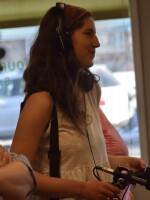From above, the seaweed on the beaches of Homer and Anchor Point doesn’t look like much.
But up close, there are entire worlds in every sample. That’s what University of Alaska Fairbanks researcher Brian Ulaski found when he analyzed the seaweed that had washed up on Homer beaches — also called wrack. His team found tens of thousands of organisms in samples they collected on the southern peninsula in 2021.
“The next time you’re walking the beach, if you look a little bit closer at that wrack line you might be surprised at how much life you find in there,” Ulaski said.
Ulaski’s study, published in May, comes on the heels of an uptick in interest in harvesting wrack.
Seaweed from Alaska’s beaches makes really great plant fertilizer. One farmer in Anchor Point, Al Poindexter of Anchor Point Greenhouse, has been using seaweed for decades to make a potting soil called Fishy Peat.
And more people on the Kenai Peninsula are catching on. In the last couple years, the Alaska Department of Fish and Game has started issuing permits for the harvest — about three per year. The season for harvesting is open September through April.

“A lot of local folks collect wrack off the beach for their gardens,” said Fish and Game Research Biologist Ted Otis. “We were just trying to get ahead of it a little bit and learn a little bit about that resource.”
Now, researchers are putting seaweed under the microscope to make sure that harvest isn’t causing harm to the populations that rely on it to survive.
“We realized that [harvesting] kelp on beaches wasn’t like going out and picking up driftwood or rocks,” said Area Management Biologist Glenn Hollowell. “This stuff may have value.”
To learn more, Fish and Game got in touch with the University of Alaska Fairbanks. That’s where Ulaski, a postdoctoral fellow at UAF’s College of Fisheries and Ocean Sciences, came in.
To gather samples, he used clam guns to punch holes into the wrack line and the sediment below at about a dozen sites near Homer, from Anchor Point to Bishop’s Beach on one side of Kachemak Bay, and then between Seldovia and Grewingk River on the other.
“When we looked at those samples in the lab and under the scope, there were a lot of critters,” he said.
Over more than six months of sampling, he found over 47,000 different invertebrates in the wrack, like coastal centipedes and pseudoscorpions.
“You don’t really see much activity in the wrack unless you're looking at it very closely,” he said. “So it was kind of a pleasant surprise the amount of organisms we found in those samples.”
Brenda Konar is a professor with the College of Fisheries and Ocean Sciences. She said the study is a good benchmark for what organisms are found in the wrack.
“So if there’s any question or concerns about certain types of organisms or certain species, we kind of can go to this list and say, ‘Well, we know these things exist there,’” she said.
Konar said that information is important for other species that feed on wrack in those areas, like birds. Ulaski said in future research, he’d want to look into the impacts of wrack on shorebird abundance.
“And that’s one of the concerns — that if too much of it is harvested, then all of these organisms that these birds rely on aren’t going to be around, because their habitat isn’t there,” Konar said. “And it's especially important during times when there’s a big bird flyover — especially in the Homer area."
Konar said harvesters should think about the tiny but abundant ecosystems they’re harvesting when they hit the beaches on the southern peninsula.
Hollowell, with Fish and Game, said already, further research on wrack is informing the work he does at the management level. He said a presentation Ulaski gave to the Board of Fish in 2019 helped inform policy on commercial and personal use seaweed harvest at the state level.




